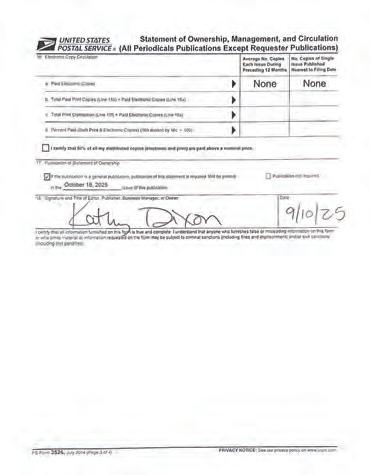








Virginia Farm Bureau





MADE WITH LOVE
Handcrafted pet snacks made with Virginia ingredients are a labor of love for a treatmaker who partners with local farms.
From sage to maple, Virginia sausage makers cater to distinct regional palates of the state’s sausage eaters.
Soybeans feed livestock and humans, are used in household and industrial products, and now make up firefighting SoyFoam®.
Give the gift of a unique agritourism experience this holiday season—an oyster tasting tour, camping with alpacas or a one-stop-beverage destination.
Trout farming offers some farmers the opportunity to diversify and some ship direct to restaurants.
Associate members will receive their next issue of Cultivate in February. The magazine is published quarterly, and back issues can be viewed at issuu.com/virginiafarmbureau
“The farmers work hard at providing good, clean food for all of us, so what can we do to take care of product they aren’t offloading?”
— KRYSTAL BARNES, Pawfect Sweets, Henrico County
Volume 18, Number 4 Fall 2025
Cultivate (USPS 025051) (ISSN 1946-8121) is published four times a year. February, May, August, October. It is published by Virginia Farm Bureau Federation, 12580 West Creek Parkway, Richmond, VA 23238. Periodicals postage rate is paid at Richmond, VA and additional mailing offices. The annual Subscription Rate is $1.13 (included in membership dues).
Postmaster: Please send changes of address to, Cultivate, Virginia Farm Bureau Federation, P.O. Box 27552, Richmond, VA 23261; fax 804-290-1096. Editorial and business offices are located at 12580 West Creek Parkway, Richmond, VA 23238. Telephone 804-290-1000, fax 804-290-1096. Email address is Cultivate@vafb.com. Office hours are 8 a.m. to 4:30 p.m., Monday through Friday.
All advertising is accepted subject to the publisher’s approval. Advertisers must assume liability for the content of their advertising. The publisher assumes no liability for products or services advertised. The publisher maintains the right to cancel advertising for nonpayment or reader complaints about services or products.
Member: Virginia Press Association
EDITORIAL TEAM
Kathy Dixon Assistant Director, Online & Print Communications
Nicole Zema Sr. Staff Writer/Photographer
Christina Amano Dolan Staff Writer/ Photographer
Kenny Kane Graphic Design Manager
Eleanor Stickley Sr. Graphic Designer Alice Kemp Sr. Staff Writer/Advertising Coordinator
MEMBERS — Address change? If your address or phone number has changed, or is about to change, contact your county Farm Bureau. They will update your membership and subscription information.
Although there are seven native mistletoe species in the U.S., only American Mistletoe— Phoradendron leucarpum grows right here in Virginia.
Historians traced mistletoe legend to Celtic druids of the 1st century A.D., who viewed it as a symbol of fertility since it thrived during the winter. The Greeks used it medicinally during medieval times. The Romans viewed mistletoe as a sign of peace and resolved differences underneath it. And in Norse mythology, the goddess Frigg declared it a symbol of love and said those who stood beneath it deserved a kiss.
While its connection to Christmas decorations is unclear, it’s thought


to have been displayed during the holiday since at least the 18th century. Historians attribute the Christmastime mistletoe kissing tradition to English servants. It’s believed that when Europeans settlers immigrated to North America, they discovered a plant that closely resembled the mistletoe from their homeland.
A hemiparasite, mistletoe needs trees to survive, but it also photosynthesizes, allowing it to stay a festive green throughout the winter.
Mistletoe thrives in the temperate climate of Virginia’s coastal plains and swampy forests, and grows on a range of trees, particularly oaks, red maples and gum trees.
Because it nestles high in treetops where birds perch, there isn’t an easy way to collect mistletoe short of climbing, using a bucket truck or shooting it down.
People seeking mistletoe for their holiday decorations can find sprigs
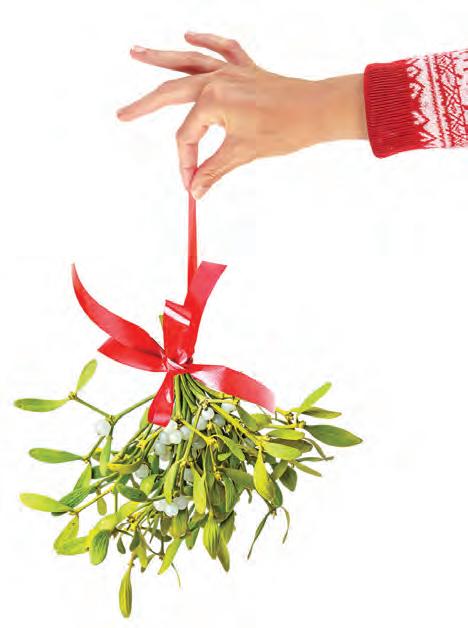
for sale at local florists, garden centers, nurseries and other holiday retailers. Many tree farms also sell it alongside their Christmas trees. Mistletoe available commercially often is harvested by climbers who sell it wholesale.

600,000


That’s how many acres of soybeans are harvested annually in Virginia. And those soybeans are used in a surprising number of ways—from food products to shoes. See related article on page 13.








Featured this month on Real Virginia, Virginia Farm Bureau’s weekly television program:
• Learn how farmers cut creative corn mazes for visitors to explore this fall.
• Find out how farmers are faring one year after they were hit hard by Hurricane Helene.
• Discover ways to identify poison ivy and learn how to prevent the oil from getting on your skin.
Real Virginia airs nationwide at 4:30 p.m. on the first and third Saturdays of each month in the Voices of Agriculture program on RFD-TV on Dish Network and DirecTV; and on selected cable outlets around the state. It airs weekly on WBRA digital channel 15.2, the WHRO World Channel, WVVA Bluefield and WTKR Norfolk, and on the first and third Sundays of each month at 10 a.m. on WVIR Charlottesville and at 10:30 a.m. on WHSV Harrisonburg; and on the first and third Saturdays at 8 a.m. on WRLH Richmond and at 5:30 a.m. on WSLS Roanoke.
Time is money, and efficient labor tracking reduces administrative work and costly errors.
The process of manually tracking labor, piece rate production and ever-changing wage rates exposes farmers to a wide range of costly errors and litigation. With FieldClock®, you have the power to manage your farm labor in real time and access that data from anywhere!
In addition to saving time and money with FieldClock®, current Virginia Farm Bureau members save an additional $10 off their monthly bill!
And with a mobile device, you can manage your farm in real time and access that data from anywhere!
Visit FieldClock.com/Virginia-Farm-Bureau today to get started!
*Details and Restrictions
Must be a valid member of Farm Bureau.
A valid member email address is required for eligibility.
Virtual Care RX offers Virginia Farm Bureau members a discounted subscription rate for more than 1,100 acute and chronic medications at no cost. Plus, members will get access to virtual primary and urgent care 24/7/365.
Subscription prices for the medication program start as low as $20.65 per month, which gives you access to 70,000 in-network retail pharmacies. After your first fill at a retail pharmacy, your chronic medication will be mailed monthly with free shipping.
Members also have access to the Prescription Assistance Program for discounts on many medications over $200. Additionally, members will have access to the Insulin Discount Program, a one-stop solution for high quality brand and generic insulins and associated diabetes medications. Prices start as low as $94.99 a month for insulin, service and shipping.
Through Virtual RX’s Virtual Care Program, members can connect directly with a primary care or urgent care physician via phone or video conferencing 24/7. Virtual mental health support also is available for an additional cost of $35 per visit for a therapist or counselor. Virtual Care prices start at $26.95 per month. For complete pricing and to learn more, call 877-256-4248 and mention you are a VFB member, or visit virtualcare-rx.com/home-virginia-farm-bureau-federation/
Enterprise, National and Alamo are all part of the same family of brands.
And now Virginia Farm Bureau members get exclusive savings on all three car rentals! Members will receive a discount of 5% to 20% on these brands.
Each of these three rental car companies share the same mission of getting you where you want to go, with excellent customer service along the way.
No matter which brand you choose, you’ll enjoy a large selection of clean, reliable rental vehicles and the convenience of more than 7,600 neighborhood and airport locations.
Choose from great rates on a large selection of standard, exotic and luxury vehicles. To activate your discount, log in to vafb.com or call 844-661-7135.
Member Deals Plus® uses the nation’s largest private discount network to save you money on meals, clothing, vehicle care and other goods and services. It uses “show your phone” mobile deals that can be accessed anywhere and redeemed from a smartphone at the point of sale, or from a home computer.
• To register as a new user, visit vafb.com/benefits.
• To save with a mobile device, download the “Member Deals Plus” app from the AppStore or Google Play.
Members can enjoy discounts on amusement parks, apparel, dining, gifts, movies, museums and more!
For assistance, call Member Deals Plus customer service, 888-275-9136.
Member Deals plus and Member Deals Plus are registered trademarks of Virginia Farm
Bureau Federation.
























ARTICLE AND
BY CHRISTINA AMANO DOLAN
Love is the most important ingredient in any recipe—especially for those who enrich our lives.
Pets grace our homes with unconditional love, devotion and joy.
“They’re family,” said pet treat maker Krystal Barnes of Henrico County, who’s been surrounded by furry companions throughout her life.
While navigating her own medical journey, Barnes’ life changed when her Yorkie-Chihuahua mix, Milky, fell ill as a puppy from poor blood sugar regulation.
“She’d just throw her head back, and I couldn’t get her to put it down. It scared the life out of me,” she recalled.
“Every time I’d give her soft food or kibble, it would happen within 24 hours, so I thought, ‘I’m just going to make your food and see what happens.’”


















Milky’s cure was the catalyst for one of the most diverse lines of pet treat products grown, made and handpackaged in Virginia—crafted with love at every step.
Since officially launching the Pawfect Sweets business in 2022, the Barnes family has transformed their home into a pet treat-making powerhouse.
Krystal, husband Chris and their daughters, Kaleeya and Asata, all chip in—constantly cooking, baking and packaging an array of bone treats, dehydrated products, “Woofles,” freeze-dried items and other bakery goods from scratch using fresh, locally grown ingredients.


Their treats are certified delicious by the family’s team of tasters—Milky, their husky mix Amara, German shepherd Grizzly, and shepherd puppy Dolly.
Humans and animals alike are enticed by the Pawfect Sweets selection at various area farmers markets, with many customers tasting the humangrade products alongside their pets.
“We want to make sure our pets are eating as healthy as we are,” Chris remarked.
Like people, dogs and cats have allergies, dietary restrictions and picky palates—something Krystal discovered from interacting with market customers.
“My goal is to give everybody the opportunity to buy good, healthy treats for their pets,” she said.
Her treats are methodically cooked to preserve essential nutrients and serve a variety of sensitive stomachs and allergies.
The Barnes’ hard work is rewarded by wagging tails, heartwarming stories and blossoming friendships at the market.
“You didn’t know this person, and now you’ve created this wonderful bond out of a shared love for their dog,” Krystal reflected. “I don’t care about any moment that I didn’t sleep or it was hard, because it’s the most fulfilling thing I’ve ever experienced.”
Farmers markets are where fruitful community partnerships are born— bringing the Barnes’ vision of locally grown goods to life.





A conversation at the Ashland Farmers Market with vendor and farmer Paul Boulden of Studley Farms led to a far-reaching collaboration between the two family businesses.
The Hanover County farm produces its own line of beef liver and pork liver pet treats, but labor challenges and limited marketing opportunities often resulted in a stockpile of unused animal products.
“My thought was: The farmers work hard at providing good, clean food for all of us, so what can we do to take care of product they aren’t offloading?” Krystal explained.
In addition to supplying the Barneses with premium products like pork skin, beef liver, chicken heads and feet, Boulden initiated connections with other local producers.
“Every farmer that I’ve ever met has an aversion to waste,” Boulden remarked. “As soon as we can help producers find an outlet for products that would otherwise be wasted, they get very excited about that.”
The Barneses also incorporate locally grown fruits and vegetables into their recipes—optimizing the harvests of market vendors like Agriberry Farm and Leslie’s Garden.
“To the human eye, you might not want that apple or peach because it has a bruise on it, but dogs think it tastes great!” Krystal quipped.
And with ample kitchen and storage space in the new Pawfect Sweets storefront in Henrico, Krystal can look forward to partnering with more Virginia farms and businesses.
Treat your furry companions to Virginia-grown stocking stuffers— from Studley Farms’ premium beef liver and pork liver pet treats to Pawfect Sweets’ variety of handsewn pet accessories, cat nip toys and pet treat stockings. Visit pawfectsweets.com, studleyfarmsva.com, or the Pawfect Sweets and Studley Farms Facebook pages for more information on their various products, updated market locations and schedules, and ordering options.
Homemade dog biscuits recipe
2 ripe bananas
½ cup unsalted peanut butter
1½ cups uncooked oats
Important safety tip! Check your peanut butter’s ingredient label to ensure it does not contain the artificial sweetener xylitol, which is very toxic to dogs.
Heat oven to 350°.
Use a blender or food processor to grind up the oats into a fine powder. If you don’t have access to oats or a blender, substitute regular flour.
Mix all ingredients together and roll into a thin sheet. If the dough is crumbly, add another tablespoon of peanut butter.
Use cookie cutters or the opening of a water glass or coffee mug to create dog biscuits.
Bake biscuits for 10 minutes.
Store in an airtight container for up to 2 weeks.
—Recipe adapted from Pueblo County Colorado State University Extension

ARTICLE AND PHOTOS BY
NICOLE ZEMA
Be it breakfast, lunch or dinnertime, a carnivore’s delight becomes a dilemma when choosing from so many flavorful styles of Virginia-made sausages.
From inventively seasoned multi-species blends to American traditional styles and cross-cultural varieties, Virginia’s sausage makers cater to distinct regional palates and adventurous carnivores alike.
In August, Paul Boulden of Studley Farms cuts meaty chunks of pork leg quarters, loin and shoulder meat for a 250-pound batch of chorizo sausage in a state-inspected butchering facility
he shares with C.J. Isbell at Keenbell Farm in Hanover County.
“A lot of people assume that sausage is trash meat,” he said. “But the U.S. Department of Agriculture prohibits the use of adulterated or pork by-products in sausage, and it can’t have more than 50% fat volume.”
Their respective brands are sold in Keenbell’s retail store and at Studley’s farmers market booths under their retail food licenses.
They first met in 2009 at the Ashland Farmers Market where Keenbell Farm was selling pasture-raised meat.
“My wife Kim and I started making sausage for our own consumption,” Boulden said. “Eventually, C.J. invited me to
come out. It’s a good relationship, under two separate brands.”
Virginia sausage is a relatively niche market, and makers share resources.
“Paul and I are aligned in our values and ethics in animal husbandry, integrity of the product and transparency with customers,” Isbell said.
While he focuses on “traditionalist” sausage styles like beer brats and mild Italian, Boulden’s clientele knows him for products found in the European market. With the largest product diversity in the state, Studley Farm’s sausage styles include English bangers, French country, Hungarian Kolbasz, Polish Kielbasa-Biala, Russian dill and many more.

His venturesome customers go for his creative blends, like spinach and feta sausage with lamb and goat, or chicken Thai curry sausage.
“I’m not as cultured as Paul and what I call his ‘weird sausages,’” Isbell joked. “Albeit we had the same belief system in crafting sausages, he exposes me to things I never would have tried.”
Consumer preferences for sausage are hyper-regional, Boulden explained.
“In Central Virginia, sage sausage is king,” he said. “We doctored that recipe for the local palate with sage, black and
red pepper, nutmeg and ginger.”
Shenandoah Valley palates seek sweeter styles with maple or brown sugar, Boulden said.
“That’s just what their grandma and mom always made,” he noted. “It’s region-specific.”
How the sausage is really made
At Gore’s Fresh Meats in Frederick County, butchers broke down a whole hog in the morning, grinding primal cuts of loin, Boston butt and ham into Italian bratwurst, kielbasa and chorizo by afternoon.
“All the good parts,” said butcher Cody Harrison. “Fat is added so it’s not too lean.”
Brothers Joe and Jeff Gore are third-generation farmers, now patriarchs running the family business. Operating for over 60 years, the enterprise includes the Stephens City retail shop, plus a custom state-inspected processing plant and USDA-inspected slaughterhouse for wholesale distribution.



Gore’s offers fresh sausage varieties including smoked andouille, bratwurst, chorizo, Italian, kielbasa and breakfast links.
“We’ve always made sausage the way we’d want it done for us,” Joe said.
For the natural link casings, Harrison rinsed and rehydrated pork intestines preserved in salt. Ground kielbasa sausage is gently fed through a stuffer into casings, and hand-twisted at the desired length.
Their meat is purchased from regional farmers and at youth livestock sales. “Word of mouth is their No. 1 marketing strategy,” said market manager Keighley Gore, who married into the family.
They contribute about 2,000 pounds of sausage biannually for the Winchester-Kiwanis Pancake Day fundraisers, and gifts for multiple community campaigns.
Buying animals from youth livestock shows at area agricultural exhibitions also enhances local brand awareness while helping the kids.
“We eat that cost as part of the advertising budget,” Gore continued. “The product is labeled ‘purchased from youth.’ The public might not be able to go to the fair or afford it themselves, but they can get it from us as a show of support!”
When cooked on high heat, sausage casings burst and release the juices, resulting in a dry or brittle sausage. Moisture, low-medium heat and a little patience get the best results. Virginia’s sausage specialists shared their tried-andtrue cooking methods:
• “To avoid breaking large dinner sausages, simmer them with some water in the skillet. When the water evaporates, the sausage is cooked thoroughly, and faster.” Morgan Williams, Gore’s Fresh Meats supervisor
• “I like links cooked on the grill or blackstone. But if I’m being careful of splatter, I put sausages in the oven on a cookie sheet.” Keighley Gore, Gore’s Fresh Meats manager
• “Even if the casing does not burst, overcooking a sausage will result in the stratified fat within the sausage melting out, yielding a dry and flaky sausage. I like to err on the side of flipping more often, rather than risk drying out one side. Keep a glass of water nearby, should more moisture be needed.” Paul Boulden, Studley Farms



Find STUDLEY FARMS sausage and other meat products at Central Virginia farmers markets: Ashland, Yorktown, Birdhouse and the new Hanover Market. Also visit studleyfarmsva.com, or the Facebook page for updates.
Purchase KEENBELL FARM sausage and farm products at the retail store on Fridays and Saturdays, located at 18437 Vontay Rd. in Rockville. Also visit keenbellfarm.com, or the Facebook page for updates.
Shop the broad inventory at GORE’S FRESH MEATS at 201 Centre Dr. in Stephens City. Also visit goresmeats.com, or the Facebook page for updates.
It’s soy surprising!
ARTICLE AND PHOTOS BY NICOLE ZEMA
From edible ingredients on the dinner table to structural materials underfoot, soybean products have a place in every household.
Beyond soy-based foods like tofu, natto, edamame, miso and tempeh, soybean oil is an essential ingredient in hundreds of food products including margarine, salad dressings, breads, cakes, pies and cookies.
“If you look at the labels on Duke’s mayonnaise or Chick-fil-A sauces, soybean oil is one of the first ingredients,” said Rachel Gresham, executive director of the Virginia Soybean Association.
The organization supports growers and raises public awareness of soy’s uses and potential.
“In conjunction with the United Soybean Board, we work to support market development and end-uses for soybeans grown in Virginia,” Gresham continued. “For example, Goodyear utilizes U.S. soybeans in some of their tires. Skechers picked up that technology for the soles in the shoes I’m wearing right now!”
About 600,000 acres of soybeans

are harvested annually in Virginia. Accomack County leads the pack at 29,000 harvested acres, followed by Mecklenburg, Sussex, Caroline, Essex and Northampton counties.
Soybeans and soybean meal are Virginia’s No. 1 export, earning over $1.4 billion in 2023.
“Most of our soybeans are used for our poultry and livestock feed, so it ends up on our dinner tables one way or another,” said Robert Harper, grain marketing specialist at Virginia Farm Bureau Federation. “They’re little protein pills incorporated into a ration. But you can’t feed them to livestock or poultry without processing at some level.”
Perdue Agribusiness brings together grain trucks, barges and rail to load bulk vessels with soybeans and soybean products at its deepwater port in Chesapeake. They send bulk vessels and containers of soybeans and soybean products to the Port of Virginia for international trade. Perdue’s facilities crush beans for soybean oil, meal and soyhull pellets. These products are used in cooking oils, livestock and poultry feed, and biodiesels.
To be soy bold
But wait. There’s more.
“My favorite thing about soybeans is how many unexpected products you can make with them!” Gresham continued. “SoyFoam® is one of those end-use initiatives.”





above: Soybeans are crushed into meal at the Perdue Agribusiness deepwater port in Chesapeake. Soybean products are shown in various forms, from left: oil, meal, soyhull pellets and whole beans. Bulk vessels and containers of soybeans and soybean products move through the Port of Virginia for international trade.
Below, Alan Snipes of Cross Plains Solutions works with the United Soybean Board, developing products with soy proteins like SoyFoam®—a firefighter training foam that is non-toxic and biodegradable. A liquid mixture of soy flour and water creates thick, foamy suds that quickly extinguished fires set by Spotsylvania County Fire & Rescue trainees at Rappahannock Regional Training Center for a SoyFoam® demonstration.
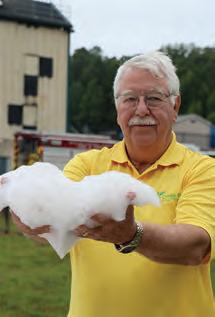



A blast of thick, foamy suds quickly extinguished fires set by Spotsylvania County Fire & Rescue trainees at Rappahannock Regional Training Center during a SoyFoam demonstration in August. Founder Alan Snipes of Cross Plains Solutions in Georgia has been working with the USB for almost 30 years, developing products with soy proteins.
An industry associate was working on a soy-based adhesive that had a problem with foaming. Meanwhile, a New York fire department was seeking a firefighter training foam that is nontoxic and biodegradable.
Snipes saw an innovative opportunity— mixing soy flour with water.
“All I know about firefighting is the red, shiny truck coming down the road,” he said. “But they asked to try the foam, which seemed to work pretty well.”
The product passed extensive testing for toxicity, soil and aquatic biodegradability, and sewer safety. For decades, “forever chemicals” like PFAS, or polyfluoroalkyl substances, have been used in firefighting foams. But with more awareness of PFAS’ environmental and health impacts, researchers sought safer alternatives like SoyFoam.
Gresham said her team has met firefighting families touched by cancer.
“It’s the safest product we could put together available on the market,” Snipes said. “We’re currently active in over 100 U.S. fire departments, picking up more every day.”
The company is currently working with the U.S. Forestry Service on certification to use SoyFoam in controlled burns. A sprayer creates a wet line of foam around the burn zone.
Will Edwards, sustainability consultant for the U.S. Soybean Board, noted that many rural fire departments are staffed by farmers.
“Potentially, the soybeans they grow may be used by their fire departments!” he said.

Sustainable soybean-derived materials and products we use daily include:
Soyprising end uses
The House that Soy Built is a dollhouse-sized demonstration of everything that could be made of soy in the home, including bath products, food items, furniture foam, pet food, flooring, crayons, toys and more.
The Virginia Soybean Association shares this and other educational materials annually at the State Fair of Virginia and various public events.



















































































































Most of us are familiar with traditional agritourism operations—pick-your-own pumpkins, corn mazes and hay rides— but some Virginia farmers are taking it to the next level. This holiday season, impress your friends and relatives by gifting them with an unusual agritourism experience. We’ve explored three different options across the state, but there are more waiting to be discovered.
ARTICLE AND PHOTOS BY ALICE KEMP
Gliding along the calm Lynnhaven River, Capt. Chris Ludford points to a stony outcropping in the water.
“Anything you see today that looks like rocks, it’s actually oysters,” he tells a handful of guests on his boat.
The group is aboard one of Ludford’s oyster tours. Blending education, history and local flavor, the owner of Pleasure

House Oysters Farm in Virginia Beach immerses visitors in the area’s aquaculture heritage and illustrates how the bivalves are raised from seed to shuck.
Once anchored on his farm, everyone wades into a shallow, sandy outlet scattered with oyster cages.
“They grow from the size of a fingernail to full-grown—about 3 inches—in a year,” Ludford explains, holding a handful of juvenile oysters from the nursery cages. “For wild oysters, it takes three years.”
A lifelong waterman, Ludford sold crabs from a young age. He ventured into oysters after retiring from a firefighting career, eventually growing thousands of his signature Pleasure House Oysters for local restaurants.
But interest soon shifted to how oysters are raised. And a decade later, “tours have taken center stage.”
Though Ludford still operates 60 acres of farmed and wild oysters, tours are 90% of his business—often running daily during peak summer tourist season. His tours range from a two-hour tasting excursion to a full “Chef’s Table” experience with fresh-caught oysters
and seafood prepared on the riverbank.
For a hands-on adventure, the Waterman’s Tour lets guests use tongs and equipment to pick their own oysters—and crab, eels and fish pots when in season.
“I tell people to bring a cooler because they’ll take home some clams, oysters and crabs,” Ludford quipped.
Back on board, it’s time for a tasting. Ludford shucks fresh Lynnhaven oysters and passes them out. Known for their buttery, slightly sweet flavor, Lynnhavens were prized by royalty during the 18th and 19th centuries. Though habitat loss, overfishing and pollution devastated their numbers, growers like Ludford worked with conservation groups to restore the Lynnhaven’s water quality and oyster populations.
Tours like these “get people closer to their food,” he noted.
“I’ll get people who never had an oyster,” he added. “They’ll buy the trip as a gift for a family member who likes them, and they might try their first oyster and walk away with a whole different mindset.”
For more information, visit pleasurehouseoyster.com









ARTICLE AND PHOTOS BY NICOLE ZEMA
Ki m Wynn loves the idea of seeing a herd of alpacas peacefully grazing outside her kitchen window. Apparently, so do thousands of other people.
Kim and Tom Wynn bought their first alpacas in 2010, opening their farm to visitors at their Cobb Hill Alpacas in Rural Retreat.
“They’re fiber animals, I’m a crafty person, and it all fell into place,” Kim said. “We started with four females. It was a learning process.”
The Wynns relocated to a scenic property outside of Wytheville in 2015. Their herd has since grown to 17 alpacas.
“The real agritourism for us started with COVID,” Kim continued.
They listed their immersive farm experience on the camping network Harvest Host.
“Guests get a one-night RV stay on your
property, and in turn, they support your farm,” she explained. “We gave them tours and could practice social distancing outside.”
International guests, out-of-state visitors and area residents from all walks of life trekked to Cobb Hill, from CEOs to stay-athome dads with their children.
“We even had teachers doing their Zoom classes from the alpaca pastures,” Kim said.
Now families return year after year. Tours are $10 each, and free for kids under age 10.
The alpaca farm is a no-touch facility for liability reasons, but visitors can get close to observe their habits and quirky characteristics.
“They all have their own personality, somewhere between a cat and a teenager,” Tom joked. “They can kick, spit on you or jump when they’re startled.”
Of Cobb Hill’s thousands of visitors, only about 15 of them were spit on.
“For some, it’s a badge of honor, even though it smells like a dirty diaper,” Tom said. “But it can be part of the experience, and they get excited about it!”
Their herd produces about 125 pounds of raw fiber, which is shorn annually.
Alpaca fiber products, both handmade by Kim and commercially sourced, are for sale in a charming on-site farm store. The inventory includes shawls, hats, ornaments, toys, yarn, socks and scarves.
For visitors from urban locales, Cobb Hill is often their first exposure to agriculture.
“We’ve had people more excited about the barn cat Callie, or our chickens, than the alpacas!” Kim said.
A little girl from Pittsburgh tearfully tried in vain to catch one of the farm’s pasture-ranging chickens, and researched capture techniques on her tablet.
“Farmer Tom, can we go out and catch chickens again?” Tom said she asked the next day. “She got one on the first try, with an ear-to-ear grin. Now she’s this tall, taking horseback riding lessons, and they are trying to buy a farm too!”
Cobb Hill Alpacas—plan your visit! Go to cobbhillalpacas.com or call 276-780-1690 to schedule a tour with at least 24 hours advance notice. Or follow updates on the farm’s Facebook page.












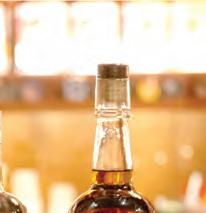





























ARTICLE AND PHOTOS BY CHRISTINA AMANO DOLAN
If you’re planning a trip to Old House, consider clearing your afternoon schedule.
This hidden Culpeper gem holds a treasure trove of one-of-a-kind experiences—from award-winning wines, spirits and brews to a tasting room steeped in World War II history.
Once the site of an abandoned alfalfa farm, the property was purchased by the Kearney family in 1998 and has since blossomed into the state’s first and only combination winery, brewery and distillery. The Virginia Foundation for Agriculture, Innovation, and Rural Sustainability helped secure grant funding to expand the vineyard in 2015—unlocking opportunities for new ventures.
“You can find something for everyone,” remarked Ryan Kearney, Old House general manager.




Visitors can admire tranquil views of the property’s sprawling 30-acre vineyards, 10 acres of wheat and 20 acres of barley while tasting a variety of white, red and sparkling wines; ales; whiskey, bourbon, tequila and other spirits.
Distiller Keith Ballurio, winemaker Chris Harris and brewer Colin Huntt keep each other motivated with some healthy competition and creative collaboration. They brought home the gold at the New York International Spirits Competition for gin; secured bragging rights for the “best brandy in Virginia” at the inaugural First Landing Cup; and won multiple golds at the Virginia Governor’s Cup for wine. They also have received consecutive awards at the Virginia Craft Beer Cup for their Irish red.
History buffs can delight in the tasting room’s rare collection of World War II artifacts acquired through history exhibit curator Patrick Kearney and donations from local families. These include a 1941 Harley Davidson Flathead, the first Medal of Honor awarded during the war, letters of surrender, and Franklin D. Roosevelt’s handwritten notations

to his famous Day of Infamy speech. More fascinating finds can be found throughout the property, including a 1942 Willys Jeep parked by the brewery.
Vibrant community celebrations come in abundance at Old House, with many locals enjoying Monday brick oven pizza on the patio May through October.
Visitors also enjoy trading stories in the tasting room and Irish pub, competing in October’s Chili Cook Off, or flocking to the annual Veterans Day extravaganza to benefit the Fisher House Foundation. The foundation offers homes for military and veteran families to stay while a loved one is in the hospital. The fundraising event features static line paratroopers falling from C-47 planes flying overhead, live music, hayrides on military vehicles and other commemorative festivities.
Other unique indulgences await, including catch-and-release fishing by the pond, Friday seafood nights with Green Ribbon Kitchen, Black Friday deals, and 12 Days of Christmas-style debuts of the latest wines, beer and spirits.
For more information, visit oldhousetoday.com
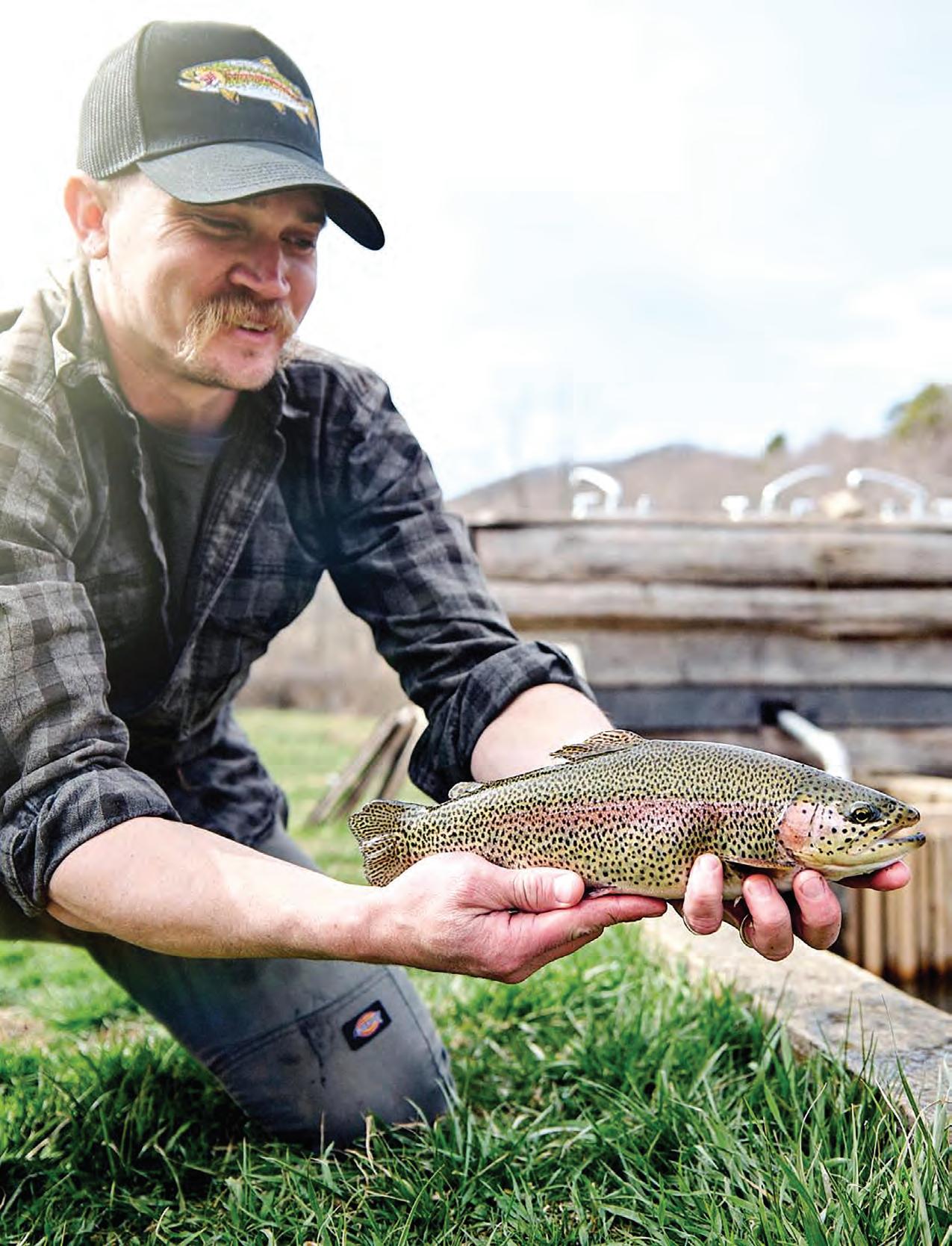


BY ALICE KEMP
Where mountain streams run cold and clear, Virginia’s waterways create thriving habitats for a fish celebrated for its delicate taste and recreational opportunities.
Each year, thousands of anglers travel to over 3,500 miles of cold-water streams, lakes, ponds and reservoirs to cast for trout in Virginia. Public fishing spots are sustained by trout stocking programs at five Virginia Department of Wildlife Resources hatcheries, while a handful of private farms harness pristine natural waters—raising their own and contributing to Virginia’s trout traditions.
Adding trout farming to a generationsold dairy operation might seem like an unlikely venture. But a cold-water spring trickling along Ingleside Dairy Farm’s bucolic fields offered the Leech family an opportunity to diversify.
“My grandad couldn’t stand all this water coming out of the ground and just running across the property line,” said Jennifer Leech, who operates the Rockbridge County farm. “He wanted to turn the water into something that would make money.”
They considered bottling and selling spring water, but determined trout would be less production-intensive and easier to fold into the dairy’s busy schedule. By 1990, the natural spring fed Ingleside Trout Farm’s hatchery, raceways and ponds that produce around 120,000 rainbow trout annually.
And although brands of artisan spring water are flooding store shelves decades later, “I’m glad we went the trout route,” she reflected.
But trout farming is very different from running a dairy.
“You can’t raise trout if you don’t have the right water,” Leech explained. “It needs to be cold—below 65 degrees.”
Their spring runs a steady 58, “ideal for raising rainbow trout..” Leech purchases fertilized trout eggs and hatches around 36,000 four times a year. During hatching, eggs are inspected several times a day, removing any that are nonviable.
“It’s tedious—you have to have good
eyes,” she said. “But if you don’t get them out, mold spreads to the others.”
Once hatched and grown into 2- to 3-inch-long fingerlings, they’re moved into raceways that mimic natural stream conditions, where they grow about an inch per month. After a year, they’ll reach 12 inches—optimal size for customers.
Selling locally for private stocking, Leech delivers trout to private ponds and creeks and supplies groups like Trout Unlimited, who sponsor community fishing events. During summer and fall, she also opens two ponds where families and anglers can enjoy a timeless pastime—and maybe catch some dinner.
“It’s a good family activity. We have grandparents that grew up fishing, love fishing and they want to bring their grandchildren.” she shared. “It’s a little bit of nostalgia, and it’s really cool to watch families just having a good time together.”
A niche in New Castle
Nestled in the foothills of the Blue Ridge Mountains, a revitalized 1930s trout hatchery is bringing artisanal trout to fine dining restaurants across the country.
“It was one of those moments in life like ‘I just gotta do this,’” recalled Ty Walker, founder of Smoke in Chimneys trout hatchery.
Six years ago, Walker was working at a grocery store when he heard about a retired trout hatchery for sale in Craig County. He and his wife, Shannon, grew up farming but knew little about raising fish. Interested, they took a leap of faith.
He found a century-old book on raising trout and used it as a guide. After clearing weeds, making repairs and feeding
water from the property’s 3,000-gallonper-minute spring into their raceways and ponds, they began raising trout like it was done nearly 100 years ago.
“I could take all the credit but it’s the clean water from the gravity-fed spring that gives the fish its really great taste,” he confessed. “Water quality is super important.”
It also requires constant attention. Trout gills strip oxygen from water, so he checks levels throughout the day. If oxygen drops too low, “things start to get dicey” and fish are moved to different ponds.
Harvesting and processing fish onsite, Walker initially sold at farmers markets. But many customers were unfamiliar with whole trout.
“Everyone knows beef and sausage, but trout is different—it’s such a niche.”
He pivoted to restaurants and now ships fresh rainbow and some native brook trout—Virginia’s state fish—on ice every Monday to chefs across Virginia and in Chicago and New York.
“Some restaurants really like brook trout,” he commented. “But they grow crazy slow, so we don’t do a whole lot of them. It’s more of a specialty thing.”
He also brines trout and uses a Texasstyle offset smoker for whole fish and fillets, which he sells online alongside trout charcuterie boxes, trout cakes and dip.
In the beginning Walker knocked on restaurant doors, personally introducing his trout to chefs. Word of mouth is spreading and today, chefs at Michelinstar restaurants are calling him.
“When we have restaurants on that level hitting us up, it’s a pretty cool feeling,” he said.
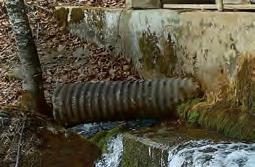
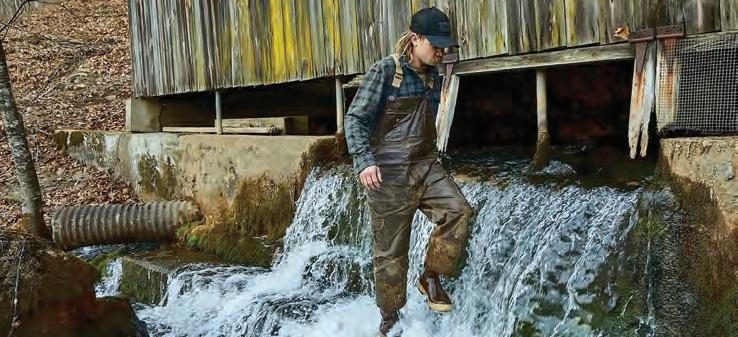

For nearly 30 years, Trout in the Classroom has provided hands-on lessons to educate thousands of students about trout and other fish in the salmonid family.
Over the course of several months, students can raise fish from eggs to fingerlings before releasing them into rivers and streams. Along the way, they explore topics like local watersheds, water quality, habitats, water resources and conservation.
Virginia’s Trout in the Classroom program is a partnership between the Virginia Council & Chapters of Trout Unlimited, various conservation-oriented nonprofit organizations, and Virginia Department of Wildlife Resources.
To learn more, visit troutintheclassroom.org.


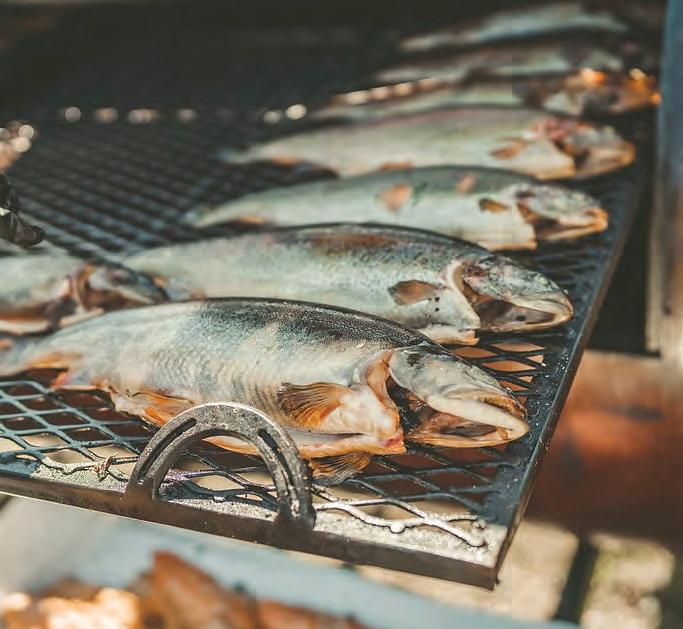

Above: State trout hatcheries operated by Virginia Department of Wildlife Resources, like Marion State Fish Hatchery, raise several species of trout to stock public waterways.
Below: At Ingleside Trout Farm, Jennifer Leech and employee Kathy Austin inspect and feed rainbow trout. Growing about 1" per month, trout are transferred to different raceways based on their size. Two picturesque ponds hold trout for recreational fishing, with some fish weighing 2 to 3 pounds or more!
Smoked whole trout is one of many products Smoke in Chimneys offers.







BY ALICE KEMP
School is back in session, football games are being played, and teens are on the roads—driving to practices, dances and friends’ houses. For young drivers, it’s a season of independence and adventure. For parents, it can be a time of worry.
That’s why Teen Driver Safety Week Oct. 19-25 is an ideal opportunity to have honest conversations about safe driving habits and roadway risks.
According to the National Highway Traffic Safety Administration, traffic crashes are the leading cause of death among teens 15-18 years old. In 2023, over 87,000 teen drivers were injured, and 2,611 people were killed in traffic crashes involving a teen driver— including 822 teen drivers themselves.

» Limit distractions. Encourage them to keep music, food and passengers under control. Consider apps or settings that block calls and texts while driving.
» Talk openly about impaired driving. Discuss the laws and dangers of alcohol, drugs and drowsy driving. Make sure they know they can always call for a safe ride.
» Emphasize seat belts. Regularly remind teens why seat belts are important, and that they must be worn while in both the front and back seats every trip, every time, and model the behavior yourself.
» Don’t rely solely on driver’s ed. Take time for practice driving sessions to improve driving skills.
“Speed, inattention, distractions, cell phone use and passengers in the vehicle all contribute to accidents,” explained John Agee, Virginia Farm Bureau Mutual Insurance Co’s director of casualty claims. “For a teenage driver, dealing with any one or several of these issues is very difficult as a new driver.”
Agee recalled a tragic case involving a 16-year-old driver who took the family’s new car out after school with a friend.
“He was driving too fast and lost control of the vehicle during a turn,” he said. “Sadly, the passenger suffered a severe brain injury and will need around-the-clock care for the rest of his life.”
While the dangers are real, parents can work with their young drivers to reinforce smart habits. Traffic safety experts recommend parents:
» Set clear rules and expectations. Establish boundaries around seat belts, passengers, speeding, phone use and nighttime driving.
» Be a role model. Kids learn from watching their parents—always buckle up, obey speed limits and avoid distractions yourself.
» Address speeding. Explain why speed matters, encourage safe driving in all weather and road conditions, and correct risky behavior.
» Check in regularly. Keep conversations going—ask about driving experiences, worries and situations they’ve faced behind the wheel.
Parents also should be familiar with the state’s graduated licensing laws, which are designed to help beginners ease into driving and limit high-risk situations for new drivers. To learn more about GDL laws, visit bit.ly/4oKtq4H
For more teen driving resources, visit the NHTSA teen driving page at nhtsa.gov/road-safety/teen-driving
Many auto insurance providers offer incentives, discounts and special programs to encourage good driving habits. Virginia Farm Bureau Mutual Insurance Co. offers a Smart Start Program with tips on Virginia driving laws and safe driving habits. New drivers under 18 who successfully complete the course can earn a discount on premiums.
Additionally, programs like Virginia Farm Bureau’s Drive2Save offer incentives for using the Routely app, which allows users to assess their driving habits. Customers can receive discounts on auto insurance for enrolling and being safe drivers.
To learn more, visit vafb.com/insurance/auto or contact your local Farm Bureau agent.

BY KATHY DIXON
Fall is decision-making time when it comes to your health insurance coverage.
Open enrollment periods for businesses, individuals and families, and Medicare recipients all begin this month or next.
“It’s very important to pay close attention to information sent by your carriers either through the mail or via email,” said Tracy Cornatzer, director of sales for VAFB Health Insurance Solutions. “Take the time to read it carefully before making any decisions.”
Federal Open Enrollment runs from Nov. 15 through Dec. 15, with a Jan. 1, 2026, effective date. The FOE provides a special open enrollment period for small businesses that don’t meet certain group requirements relating to employee participation or employer contributions to obtain coverage.
“This is a very small window,” Cornatzer said. “So, we encourage business owners to contact their county Farm Bureau office as soon as possible if they are interested in a group health insurance policy for their employees.”
Outside of this special federal open enrollment period, group health insurance is still available to purchase, but the exceptions to group requirements go away.
The 2026 open enrollment period for individual and family plans on the state marketplace runs from Nov. 1 through Jan. 30, 2026, which is a change from last year, Cornatzer said.
For those currently without health insurance coverage, now is the time to sign up. Members with existing health plans can take this time to make changes or update their information.
During open enrollment, members who enroll or change a plan by Dec. 31 will receive a Jan. 1 effective date. Those who enroll or make a change between Jan. 1 and Jan. 30, 2026, will receive an effective date of Feb. 1.
Aetna will no longer offer individual or family plans for 2026, Cornatzer said, but VAFB Health Insurance Solutions offers customers up to six other choices of carriers depending on
their zip code: Anthem, CareFirst, Cigna, Kaiser, Sentara and UnitedHealthcare.
Customers with advanced premium tax credits, which have helped to lower their monthly premium responsibility, will likely see changes to their health insurance premiums. The American Rescue Plan Act of 2021 temporarily expanded eligibility for the premium tax credit; and the Inflation Reduction Act extended the enhanced subsidies through 2025.
President Donald Trump’s H.R.1 - One Big Beautiful Bill Act did not extend the enhanced premium subsidies. At press time, those enhanced subsidies would sunset at the end of 2025.
Cornatzer said that since household income and size affect premium subsidies, “open enrollment is a good time to update your marketplace account with expected earnings for the coming year.”
Members 65 and older, or on disability, who are eligible for Medicare have available to them an enrollment period known as the Annual Election Period. From Oct. 15 through Dec. 7, Medicare customers can enroll in or make changes to certain types of plans and receive a Jan. 1 effective date.
During AEP, it’s time to reevaluate Medicare Advantage and Part D prescription drug plans. If any of your medical providers have left your carrier’s network, or if medications have changed during the year, it’s a chance to look at current coverage and if needed, enroll in a different plan.
Historically, during open enrollment there are always going to be changes, and “this year is no different,” Cornatzer said.
She explained that the representatives in Farm Bureau county offices are well-trained, having participated in annual educational sessions and certifications to help them fully understand changes in plans and in the enrollment processes.
She emphasized contacting your health insurance agent in your county farm bureau office. “Schedule an appointment to talk about your options for 2026.”
Medicare Oct. 15 through Dec. 7, 2025 >>> Jan. 1, 2026
Marketplace Nov. 1 through Jan. 30, 2026 >>> Jan. 1 or Feb. 1, 2026
Federal Nov. 15 through Dec. 15, 2025 >>> Jan. 1, 2026



BY CHRISTINA AMANO DOLAN
A drive home without watchful eyes on the road can become a financial nightmare in a flash—especially as the leaves start to change.
The chances of colliding with deer during your commute peak in the fall, when hunting and mating seasons drive droves of deer into roadways throughout the day and night.
“You can almost set a clock to deer claims,” remarked Roby Young, physical damage manager for Virginia Farm Bureau Mutual Insurance Co. “We usually see the largest influx starting around mid- to late-October, but it really gets full swing in November.”
VFBMIC handled a total of 2,682 deer claims resulting in over $13 million in losses from August 2024 through August 2025.
“Vehicle complexity increases the cost of repairs these days,” noted Anne Baskette, VFBMIC director of claims administration. “The average loss for a deer strike in 2019 was $3,240, compared to $4,866 in 2024 and 2025.”
And industry-wide repair costs for vehicles 3 years old or newer have increased by around 46%, according to CCC Intelligent Solutions.
Motorists can avoid costly deer collisions by simply slowing down and staying alert—especially on roads with previous deer sightings. Keeping hands off the phone, radio, GPS and avoiding other distractions is key to preventing any type of collision, and seatbelt safety is paramount to preventing injuries.
Next to utilizing headlights and fog lights, switching on high beams when there’s no oncoming vehicles can help illuminate lurking deer at night.
In a 2021 study of General Motors’ headlighting systems, researchers from the University of Michigan and GM found that auto high beams were associated with a 26% reduction in key nighttime crashes.
If a deer is spotted on or near the road, slow down, and consider coming to a complete stop.
“Never assume the deer standing on the side of the road are going to stay there, because once they see a vehicle approaching, they’re going to try to get to the other side,” Young cautioned.
And deer mating season, commonly known as “rut,” causes erratic activity. When bucks are chasing does, don’t expect them to look both ways before crossing the road.
“And remember that deer typically don’t travel alone,” Young added. “If you see one deer running out across the road, there’s going to be another one.”
Those living in rural areas and near farmland also should stay mindful of potential livestock on roadways. Baskette recalled a recent sighting of a stricken cow and calf during her commute.
In the event of a deer collision, pull over where it’s safe to do so and ensure the vehicle is safe to drive. If there’s fluid leakage, other visible issues or any uncertainty, call a tow truck to avoid further damaging the vehicle.
VFBMIC insureds should immediately call their insurance agent for further guidance.
“That’s what we’re here for,” Young encouraged. “File the claim and let us guide you and do whatever we can to take out all of those additional steps and headaches.”
It’s also important to call the police in case there’s a carcass obstructing the road or a future need for an incident report.
Baskette encourages all vehicle owners, including those with older models, to acquire Other Than Collision Coverage to help with common claims like glass breakage, deer damage and any other animal strikes.
Visit vafb.com/insurance/auto for more information.
When making a big spread for festivities or planning side dishes to accompany a holiday ham, a salad might not be the first thing that comes to mind.
But don’t rule it out!
A fresh, vibrant salad makes an ideal companion to a hearty holiday
feast. Pairing local, seasonal fruits and vegetables with Virginia-made products like cheeses or honey creates colorful salads that help balance out heavier fare.
Tender lettuce leaves, roasted butternut squash or pumpkin, thin-sliced apples, toasted pumpkin seeds and tangy vinaigrettes made with local cider or
infused oils bring zest and flavor without weighing down stomachs.
Whether you’re serving a crowd or hosting an intimate gathering, a thoughtful holiday salad can be as festive and satisfying as any classic casserole or stuffing—all while showcasing the season in every bite.

INGREDIENTS
For the dressing:
5 tablespoons olive oil
3 tablespoons white wine vinegar or sherry vinegar
1 tablespoon chopped fresh tarragon
1 tablespoon chopped fresh parsley
1 teaspoon salt
1 teaspoon pepper
For the salad:
1½ tablespoons olive oil
3 cups diced pumpkin
⅛ teaspoon salt
⅛ teaspoon pepper
10 ounces mixed salad greens
½ cup dried cranberries
½ cup pecan halves
¼ cup roasted, salted pumpkin seeds
Using a small bowl or a mason jar, combine all the dressing ingredients and whisk or shake to combine. Set aside.
In a large nonstick skillet, heat the olive oil over medium heat. Add the pumpkin in an even layer and cook until lightly browned on the bottom, about 5 minutes.
Sprinkle with salt and pepper and toss well in the pan. Reduce the heat to medium-low and continue cooking, stirring occasionally until the pumpkin is tender and lightly browned on the other side, about 6-7 minutes.
In a large bowl, toss the salad greens with the cranberries, pecans, pumpkin seeds and roasted pumpkin. Pour the dressing over the salad and toss well.
—Recipe adapted from US Cranberries
For the salad:
½ head red cabbage, shredded
½ head green cabbage, shredded
2 medium apples, cut into matchsticks
½ cup roasted corn
½ cup dried cranberries
¼ cup crumbled goat cheese
¼ cup sliced green onions
For the vinaigrette:
half an apple
2 garlic cloves
2 tablespoons champagne vinegar
2 tablespoons apple cider vinegar
2 tablespoons Dijon mustard
2 tablespoons lemon juice
2 tablespoons honey
½ cup extra virgin olive oil
salt and pepper to taste
DIRECTIONS
Combine the salad ingredients in a large bowl.
To make the vinaigrette, chop half of an apple and 2 cloves of garlic. Add to a food processor and blend until pieces are finely chopped. Add the remaining ingredients and blend until smooth and creamy. Pour the dressing on the salad before serving.
Recipe adapted from the New York Apple Association


INGREDIENTS
For the dressing:
½ cup extra virgin olive oil
2 tablespoons fresh lemon juice
1 tablespoon honey
½ teaspoon fine sea salt
¼ teaspoon freshly ground black pepper
For the salad:
6 cups torn kale leaves
¼ cup baby arugula
2 pears, sliced
¼ cup honey-glazed sliced almonds, or nuts of your choice
¼ cup pomegranate seeds
2 tablespoons roasted sunflower or pumpkin seeds
shards of manchego cheese
DIRECTIONS
Combine all dressing ingredients in a jar with a screw top lid and shake to blend.
Place the kale in a large bowl and drizzle with a tablespoon or two of the dressing. Massage the kale with your hands for 1-2 minutes or until it becomes tender and a deeper green color.
Pour the remaining dressing into a small serving bowl and place in the center of a large round serving plate. Arrange the kale around the bowl on the plate, forming a wreath.
Top with the arugula, sliced pears, almonds, pomegranate seeds and cheese. Spoon the dressing over the salad just before serving.
—Recipe adapted from USA Pears, Good Grief Cook

FARM BUREAU® MUTUAL INSURANCE COMPANY
The annual meeting of Virginia Farm Bureau Mutual Insurance Company Policyholders will be held at 4:00 p.m., Wednesday, December 3, 2025, at the Williamsburg Lodge, 30 S. England St., Williamsburg, VA, 23185, for the following purposes:
1. To receive and act upon the reports of the Company officers.
2. To elect a Board of Directors, each to serve a term of one year.
3. Other business as may properly come before the meeting or any adjournments thereof.
Dated this 1st day of October, 2025.
Kathleen M. Early, Secretary






Agriculture touches your life every day! Meet the Virginia farmers who raise products for your table and your community. Learn how to prepare delicious Virginia foods and cultivate a lush landscape and edible garden.
Real Virginia airs nationwide at 4:30 p.m. on the first and third Saturdays of each month in the Voices of Agriculture program on RFD-TV on Dish Network and DirecTV, and on selected cable outlets around the state. Watch anytime at vafb.com WBRA digital channel 15.2 WHRO World Channel
Norfolk WVVA Bluefield Watch weekly on:
Watch the first and third Saturdays of each month on: WRLH Richmond, 8 a.m. WSLS Roanoke, 5:30 a.m. Watch the first and third Sundays of each month on: WVIR Charlottesville, 10 a.m. WHSV Harrisonburg, 10:30 a.m.

